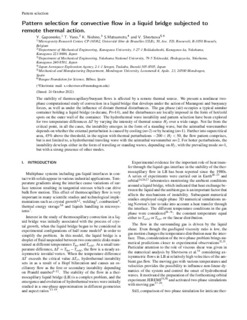
Izenburua
Pattern selection for convective flow in a liquid bridge subjected to remote thermal actionEgilea
Beste instituzio
IkerbasqueYokohama National University
Kanagawa University
Bertsioa
Postprinta
Eskubideak
© 2022 AIP PublishingSarbidea
Sarbide irekiaArgitaratzailearen bertsioa
https://doi.org/10.1063/5.0101901Non argitaratua
Physics of Fluids Vol. 34, Nº. 9 34. Article 092102. September,Argitaratzailea
AIP PublishingLaburpena
The stability of thermocapillary/buoyant flows is affected by a remote thermal source. We present a nonlinear two-phase computational study of convection in a liquid bridge that develops under the act ... [+]
The stability of thermocapillary/buoyant flows is affected by a remote thermal source. We present a nonlinear two-phase computational study of convection in a liquid bridge that develops under the action of Marangoni and buoyancy forces as well as under the influence of distant thermal disturbances. The gas phase (air) occupies a typical annular container holding a liquid bridge (n-decane, Pr = 14), and the disturbances are locally imposed in the form of hot/cold spots on the outer wall of the container. The hydrothermal wave instability and pattern selection have been explored for two temperature differences Δ𝑇���� by varying the intensity of thermal source Hf over a wide range. Not far from the critical point, in all the cases, the instability emerges in the form of a standing wave, but the azimuthal wavenumber depends on whether the external perturbation is caused by cooling (m = 2) or by heating (m = 1). Further into supercritical area, 45% above the threshold, in the region with thermal perturbations ⎯200<𝐻����𝑓����<50, the flow pattern comprises, but is not limited to, a hydrothermal traveling wave with the azimuthal wavenumber m = 2. For hotter perturbations, the instability develops either in the form of traveling or standing waves, depending on Hf, with the prevailing mode m = 1, but with a strong presence of other modes. [-]




















